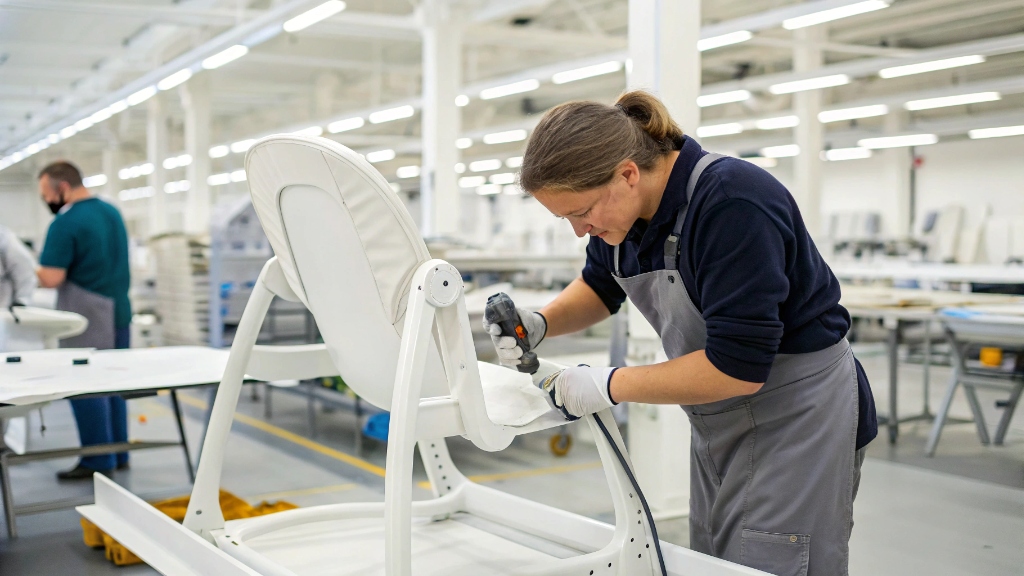Pushing a stroller on bumpy paths can be a nightmare. You feel every bump, and your baby gets jostled. I know the frustration of a rough ride; it makes every outing feel like an obstacle course. I’ve learned what truly makes a stroller glide over rough terrain.
The best strollers for uneven ground typically feature large, air-filled (pneumatic) tires, robust suspension systems, and a sturdy frame. These components absorb shocks, provide better traction, and offer superior stability, ensuring a smoother ride for your child and easier pushing for you.
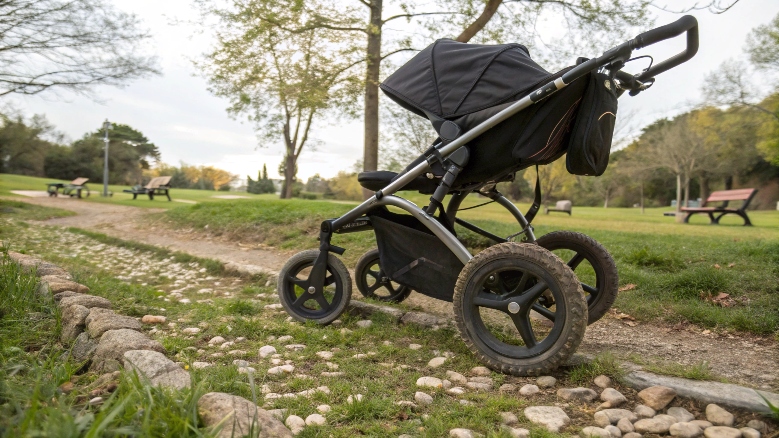
I understand the struggle of navigating cobblestones, gravel paths, or even just cracked sidewalks. I’ve been there, wrestling with a stroller that just wasn’t up to the task. My experiences taught me that not all strollers are created equal when it comes to tackling tough terrain. Let me share what I have learned.
Which Tires Make Pushing Easier?
Are you tired of your stroller wheels getting stuck or feeling every bump? It’s frustrating when tiny wheels cannot handle anything but smooth floors. I found out which tires make a huge difference.
Larger, air-filled rubber tires (pneumatic tires) make pushing easier on uneven ground. They act like shock absorbers, providing superior cushioning and traction compared to smaller, solid, or foam-filled wheels, allowing the stroller to glide smoothly over obstacles.
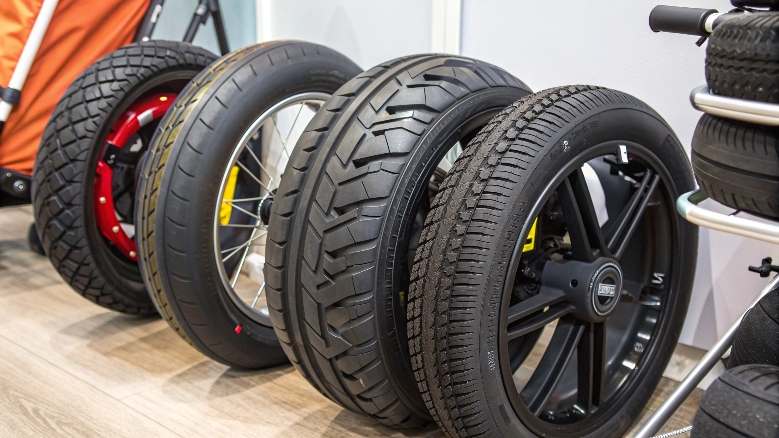
I remember one time trying to push a stroller with hard plastic wheels across a gravel path. It was a disaster. The wheels kept getting stuck, and my baby was bouncing around like crazy. It was clear right then that the type of tire makes all the difference when you are off smooth pavement. It is not just about the size of the wheel, but also what it is made of and how it is constructed. Understanding the different tire types is essential for choosing a stroller that will perform well on varying surfaces and make your pushing experience much smoother.
Understanding Pneumatic (Air-Filled) Tires
Pneumatic tires are the champions for uneven ground. These are like bicycle tires; they are filled with air. This air acts as a natural shock absorber, cushioning the ride for your baby and making it much easier for you to push over bumps, cracks, and rough surfaces. They offer excellent traction, which means they grip well on slippery or loose terrain like gravel or grass. However, they do require maintenance. You need to check the air pressure regularly, and they can get punctures, just like bike tires. Despite this, for a truly smooth ride on trails, cobblestones, or sidewalks with many cracks, air-filled tires are the best choice.
Foam-Filled (Never-Flat) Tires
Foam-filled tires are a compromise. They are often made from EVA (Ethylene-vinyl acetate) or PU (polyurethane) foam. The big advantage here is that they cannot go flat. You never have to worry about punctures or checking air pressure. This is a huge convenience for many parents. However, foam does not absorb shock as well as air. While they are better than solid plastic wheels, they will still transfer more bumps to your child than pneumatic tires. They are a good choice for mixed terrain, like suburban sidewalks and occasional park paths, where puncture protection is valued more than maximum shock absorption.
Solid Rubber and Plastic Tires
Solid rubber or plastic tires are usually found on lighter, more compact strollers, like umbrella strollers or many travel systems. They are very durable and require no maintenance. They are also typically lighter. But their main drawback is their lack of shock absorption. They transmit every bump and vibration directly to the stroller frame and your baby. They also offer less traction. These types of wheels are best suited for perfectly smooth, flat surfaces like shopping mall floors, airport terminals, or well-maintained city sidewalks. They will struggle significantly on gravel, grass, or very uneven pavement.
| Tire Type | Shock Absorption | Traction | Maintenance | Ideal Terrain |
|---|---|---|---|---|
| Pneumatic (Air-Filled) | Excellent | Excellent | Regular | Rough trails, gravel, cobblestones, grass. |
| Foam-Filled (Never-Flat) | Good | Good | None | Mixed urban/suburban, light trails. |
| Solid Rubber/Plastic | Poor | Limited | None | Smooth indoor floors, perfectly flat sidewalks. |
Can a Stroller Go Up Stairs? Is It Easy to Push Up Stairs?
Stairs are everywhere, and trying to lift a heavy stroller up them can be a real struggle. Are you curious if some strollers make it easier? I’ve certainly tried every trick in the book.
Most strollers are not designed to be pushed up stairs easily and often require lifting or carrying. While some specialized models might have features like stair-climbing wheels, for safety and ease, it is generally best to avoid pushing a stroller directly up stairs.
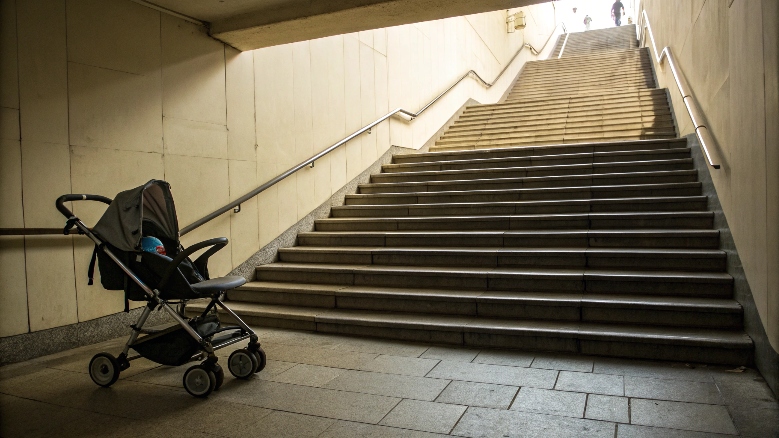
I remember a frustrating experience at a train station where the elevator was broken, and I was faced with a long flight of stairs and a heavy travel system stroller. It was impossible to push it up safely. I had to take my baby out, fold the stroller, and carry both up the stairs, which was exhausting and felt quite unsafe. This experience made me realize that while a stroller is great on flat ground, stairs present a completely different challenge. Most standard strollers are simply not built for this kind of maneuver. Attempting to push a stroller up stairs can be dangerous for both the child and the person pushing it.
Why Pushing Up Stairs is Difficult
The main reasons pushing a stroller up stairs is difficult are weight, balance, and wheel design. Strollers are designed to roll on flat surfaces. When you try to push them up a step, the front wheels get caught. You then have to lift the front of the stroller, which shifts the weight and makes it unstable. The risk of the stroller tipping backward or sideways is very high. Furthermore, the small wheels are not designed to grip stair edges, making it hard to get leverage. The sheer weight of a sturdy, all-terrain stroller, combined with a child inside, makes lifting it extremely challenging and prone to injury for the parent.
Safety Concerns and Risks
The primary concern when attempting to push a stroller up stairs is safety. There is a significant risk of the stroller tipping over, potentially causing serious injury to the child inside. The parent can also suffer strain, back injuries, or falls. If the stroller slips, it could tumble down the stairs with the child. This is why most stroller manufacturers explicitly advise against using their products on stairs. Even if you manage to get the stroller up a few steps, it is generally not a safe or practical long-term solution. Your child’s safety should always be the top priority, and that means avoiding dangerous maneuvers.
Alternatives for Stairs
When faced with stairs, the safest alternatives are either to use a baby carrier, or to fold the stroller and carry it. A baby carrier allows you to have your hands free and maintain balance while going up or down steps. If you must use the stroller, look for ramps or elevators. If those are not available, take the baby out of the stroller first. Then, fold the stroller and carry it. For lighter, umbrella-style strollers, it might be possible to lift them with the child inside for a few steps, but this still carries risk and is not recommended. My advice is to always look for the most accessible route when out with a stroller.
| Stair Maneuverability | Stroller Type | Ease of Use | Safety Concerns |
|---|---|---|---|
| Pushing Up Stairs | All standard strollers | Extremely Difficult | High risk of tipping, injury to child/parent. |
| Lifting (with child) | Lighter umbrella/travel strollers (for short steps) | Difficult | Risk of dropping, child discomfort, parent strain. |
| Lifting (folded) | All strollers | Varies by weight | Parent strain, requires removing child. |
| Specialized Strollers | Rare "stair-climbing" models | Moderate | Limited availability, still requires careful handling. |
Differences Between Various Wheel Materials and Styles of Baby Strollers?
Have you ever wondered why some strollers handle bumps better than others? It is all in the wheels, but choosing the right ones is confusing. I learned the hard way that not all wheels are equal.
Stroller wheels vary in material (rubber, foam, plastic) and style (solid, swivel, fixed), each affecting ride quality and maneuverability. Air-filled rubber wheels offer superior shock absorption for rough terrain, while solid plastic wheels are best suited for smooth, indoor surfaces.
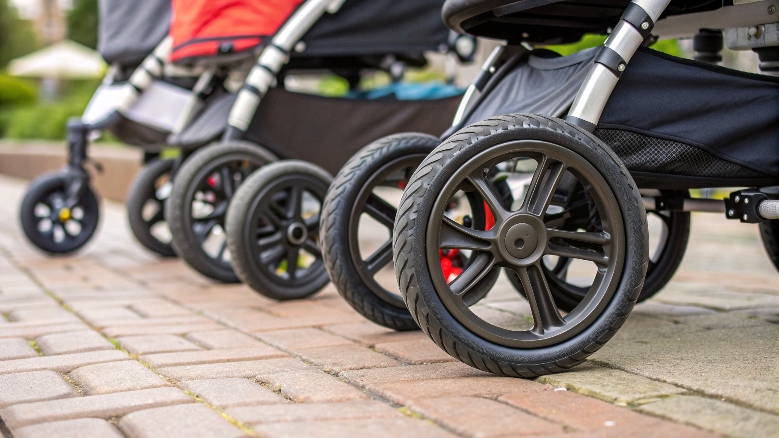
I once thought all stroller wheels were pretty much the same until I started pushing different models on different surfaces. That is when I quickly realized that the material of the wheel and how it moves make a huge impact on how easy the stroller is to push and how comfortable the ride is for the baby. It is not just about choosing a big wheel; it is about choosing the right big wheel, and understanding if it swivels or stays fixed. This knowledge is crucial for picking a stroller that matches your daily environment and activity level.
Wheel Materials
The material a stroller wheel is made from directly affects its performance. As I mentioned before, pneumatic (air-filled) rubber tires are premium for shock absorption and traction on uneven ground. They provide a very smooth ride. Foam-filled (EVA/PU) tires offer a good balance of puncture-proof convenience and decent shock absorption, making them versatile for mixed use. Solid rubber or plastic wheels are typically found on lighter, cheaper strollers and are best suited for perfectly smooth surfaces, offering minimal shock absorption. The material choice dictates how much vibration reaches your child.
Wheel Styles and Features
Beyond material, the style and features of the wheels significantly impact maneuverability and stability. Swivel wheels are typically found on the front of strollers. They rotate 360 degrees, making the stroller incredibly easy to steer in tight spaces, like crowded shops or city sidewalks. Many swivel wheels also have a locking mechanism, allowing them to be fixed in a straight position. This is important for rougher terrain, as it prevents the wheels from wobbling and provides better stability and tracking.
Fixed wheels do not swivel; they only roll straight forward and backward. These are commonly found on jogging strollers or all-terrain models designed for long, straight paths. Fixed front wheels offer superior stability and tracking at higher speeds, making them easier to push when running or on very uneven ground where swiveling wheels might get stuck. However, they make turning much harder, requiring you to lift or tilt the stroller.
Another crucial feature is suspension. Suspension systems, often found on all-terrain and jogging strollers, work with the wheels to absorb shocks from bumps and uneven surfaces. Good suspension makes a huge difference in ride comfort for your baby, especially when paired with air-filled tires.
| Wheel Feature | Material Type | Benefit | Ideal Use Case |
|---|---|---|---|
| Pneumatic (Air-Filled) | Rubber | Superior shock absorption, traction | Rough trails, jogging, cobblestones. |
| Foam-filled | EVA/PU foam | Puncture-proof, no maintenance | Mixed urban/suburban, light trails. |
| Solid | Plastic/Hard Rubber | Lightweight, durable, low cost | Smooth indoor floors, perfect sidewalks. |
| Swivel Wheels | Any material | Easy maneuverability, tight turns | City sidewalks, shopping malls, crowded areas. |
| Fixed Wheels | Any material | Stability, straight-line tracking | Jogging, long walks on uneven ground, off-roading. |
| Suspension | Integrated | Absorbs shocks, smoother ride | All uneven terrain, crucial for baby comfort. |
Conclusion
Choosing the best stroller for uneven ground means focusing on large, air-filled tires and good suspension. Avoid pushing strollers up stairs; use safer alternatives like baby carriers or folding them. Understanding wheel materials and styles helps you find the right fit for your adventures.


